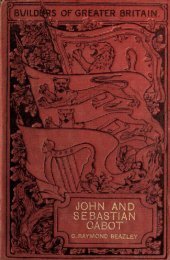st. john of damascus (676-749 - Cristo Raul
st. john of damascus (676-749 - Cristo Raul
st. john of damascus (676-749 - Cristo Raul
You also want an ePaper? Increase the reach of your titles
YUMPU automatically turns print PDFs into web optimized ePapers that Google loves.
"<br />
"<br />
jyo<br />
ST. JOHN OF DAMASCUS.<br />
observe what scientific knowledge was possessed by<br />
John <strong>of</strong> Damascus nearly a century before.<br />
What Damascenus has written on the subject is<br />
De<br />
mainly to be found in the second book <strong>of</strong> his<br />
Fide Orthodoxa." After a few general remarks, in<br />
the fifth chapter, about the visible creation, he pro<br />
ceeds to discuss the meaning <strong>of</strong> Heaven. This he<br />
defines to be that which encompasses all things, both<br />
visible and invisible. Such expressions, found in<br />
Scripture, as heaven <strong>of</strong> heavens and third heaven may<br />
be explained, without laying <strong>st</strong>ress on the Hebrew<br />
way <strong>of</strong> using a plural for a singular, as denoting (i)<br />
the air, (2) the firmament, and (3) the <strong>st</strong>arless region<br />
beyond. It is to the second, or <strong>st</strong>arry firmament,<br />
that the term heaven mo<strong>st</strong> properly belongs; and<br />
various opinions as to its nature, shape, and motion<br />
are briefly referred to. Some have held, with regard<br />
to the fir<strong>st</strong> <strong>of</strong> these points, that it mu<strong>st</strong> be a quintum<br />
corpus, or fifth variety <strong>of</strong> matter, seeing that it has<br />
properties di<strong>st</strong>inct from those <strong>of</strong> any <strong>of</strong> the four<br />
known. This refers, <strong>of</strong> course, to the doctrine <strong>of</strong><br />
the later<br />
peripatetic school, deduced from Ari<strong>st</strong>otle s<br />
treatise "De Caelo." 1 The shape <strong>of</strong> it is<br />
thought by<br />
some to be spherical, and its motion circular, while<br />
others hold it to be <strong>of</strong> a hemispherical form. Here<br />
1<br />
Lib. i., c. ii. The arguments on this topic are summed up<br />
<strong>of</strong> his De Mundo<br />
by Franciscus Coventriensis, at p. 29<br />
Peripatetico," Antwerp, 1652. The work is, I believe, very<br />
little known, and certainly does not appear to possess any<br />
scientific merit. But the frequent allusions contained in it to<br />
English persons and events it<br />
might possibly give a value for<br />
enquirers with other objects.
















